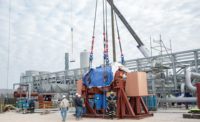Generating electricity when the sun isn't shining has long been the Achilles' heel of the solar power industry, but a new solar project in the high Nevada desert aims to solve the dilemma by becoming the nation's first commercial solar power plant to use salt storage technology.


The $900-million project is being built by Tonopah Solar Energy LLC, a unit of Santa Monica, Calif.-based SolarReserve LLC. The 110-MW concentrating solar powerplant will sit on 1,776 acres of federal land along the Crescent Dunes, about 13 miles northwest of Tonopah, Nev.
The plant will produce power by using the sun to heat salt, which stores the energy until it is needed. The technology was developed by the engineers at East Hartford, Conn.-based Pratt & Whitney Rocketdyne—the same firm that worked on the International Space Station. The technology was first field tested in the 1990s outside of Barstow, Calif., in conjunction with the U.S. Energy Dept. Although the 10-MW test project, known as Solar II, was deemed a success, salt storage technology has largely sat idle until now.
"Solar II operated for three years as a pilot project, but there was no real market for solar energy at the time, so it was shut down," says SolarReserve CEO Kevin B. Smith. "Around 2007, a renewed interest in solar power emerged."
SolarReserve last year signed a 20-year exclusive licensing deal with Pratt & Whitney to use the technology, which will enable solar electrical generation on cloudy days as well as up to 10 hours after sundown. The Crescent Dunes project received support from the Energy Dept. through a $737-million loan guarantee. Additional funding is coming from the Spanish-based bank Santander.
The plant broke ground in August in the southern portion of the Big Smoky Valley, roughly 175 miles northwest of Las Vegas. APC-Cobra, a unit of Madrid-based COBRA Group, is the engineering-procurement-construction contractor.
"The project will eventually see 600 workers during the peak of activity, with 90% of the labor force coming from Nye County," says Kevin Smith, SolarReserve's vice president of construction. Construction is scheduled to finish in the summer of 2013, with plant commissioning to follow. Commercial operation is planned for December 2013, Smith adds.
The project consists of a 2-sq-mile circular field of heliostats—reflective mirrors that resemble shiny billboards. Each 672-sq-ft heliostat is made up of 25 flat panels supported by a steel frame and a 25-ft-tall post. Anchored by thousands of small individual concrete foundations, the 17,000 computer-operated heliostats track the sun throughout the day using two independent drives that rotate both vertically and horizontally. The undertaking requires roughly 200 miles of electrical wire with 10 miles of conduit.
Like a lighthouse in reverse, the sea of mirrors concentrates sunlight to a 100-ft-tall receiver perched atop a 538-ft-high, 60-ft-dia concrete tower. Secured by a 100-ft-dia spread footing, the cast-in-place, steel-reinforced tower has an access shaft with stairs and elevator. The structure—about as tall as the Seattle Space Needle—was erected using slip-forms and a hammerhead tower crane. Harris Ready Mix, Las Vegas, is supplying the project's 125,000 cu yd of concrete.
The concrete monolith is crowned by a receiver comprised of 14 panels of nickel alloy tubes that carry a mixture of sodium and potassium nitrate. The molten salt circulates through the receiver's heat exchangers where it reaches 1,050° F. Then the salt is dropped into a pair of 20-million-gallon capacity storage tanks measuring 100 ft across and 40 ft high. The tanks rest above ground on insulated concrete foundations. Unlike water, salt can retain heat for several hours for later use. It has a 98% thermal efficiency.


Post a comment to this article
Report Abusive Comment